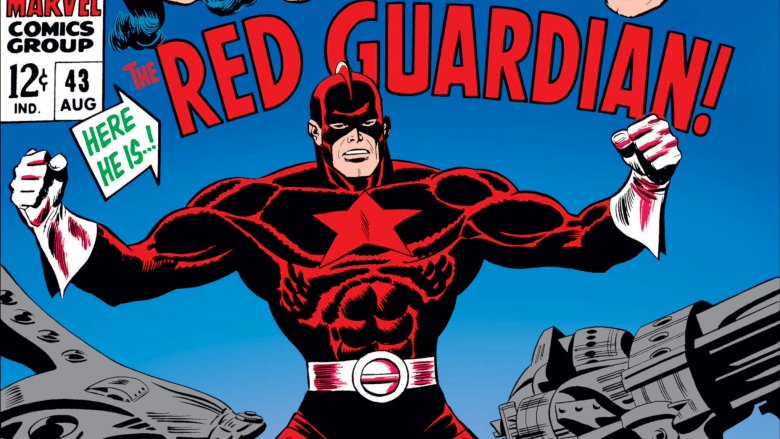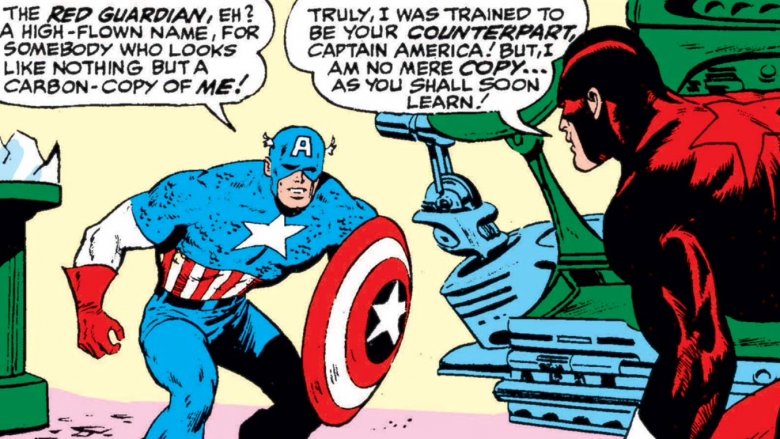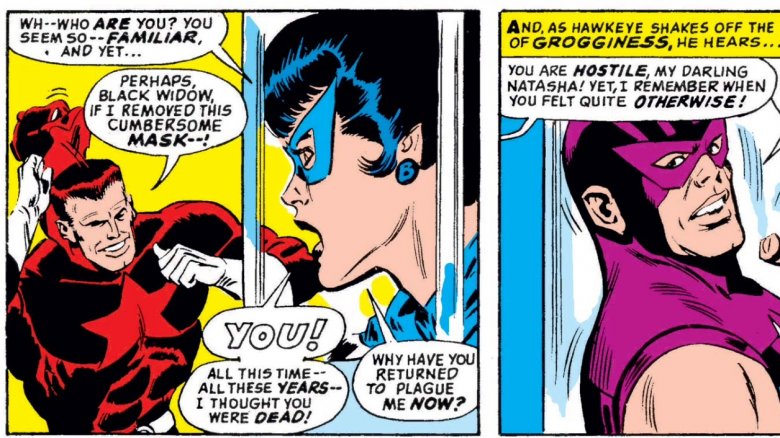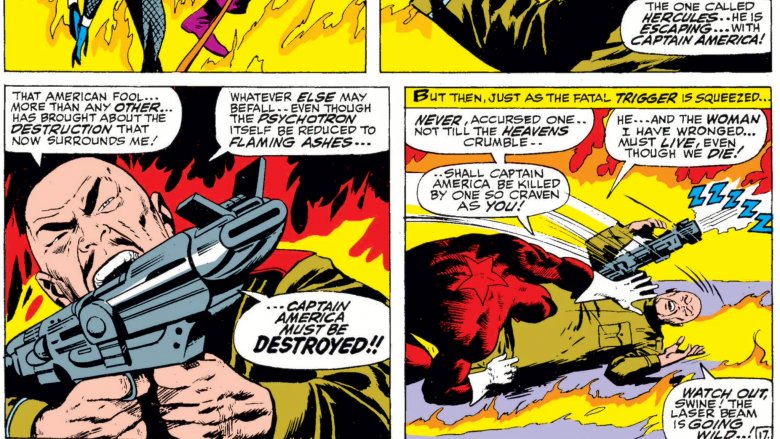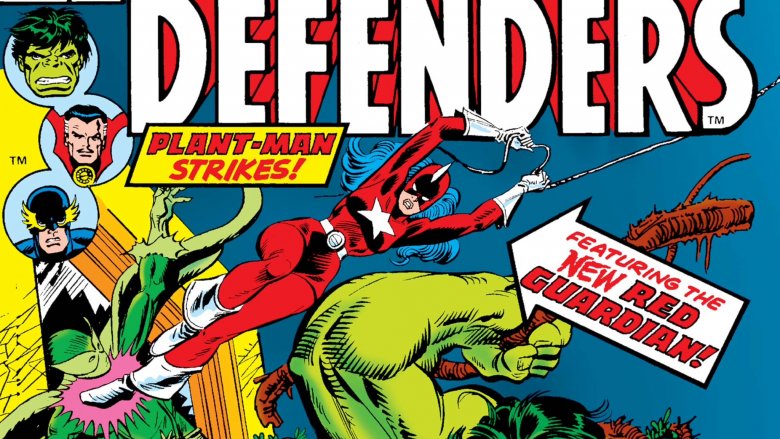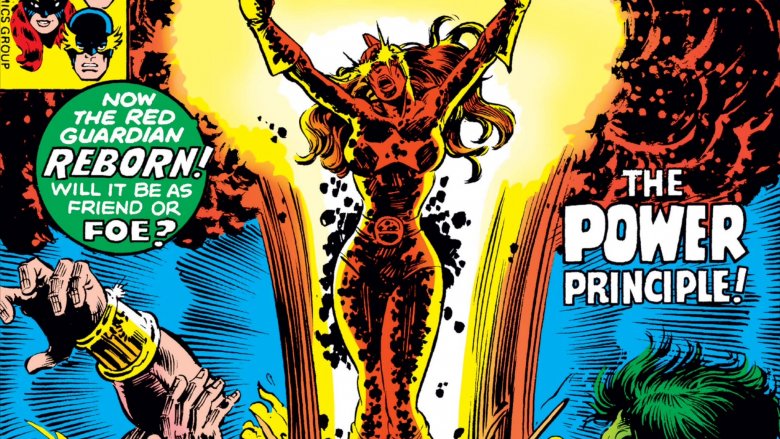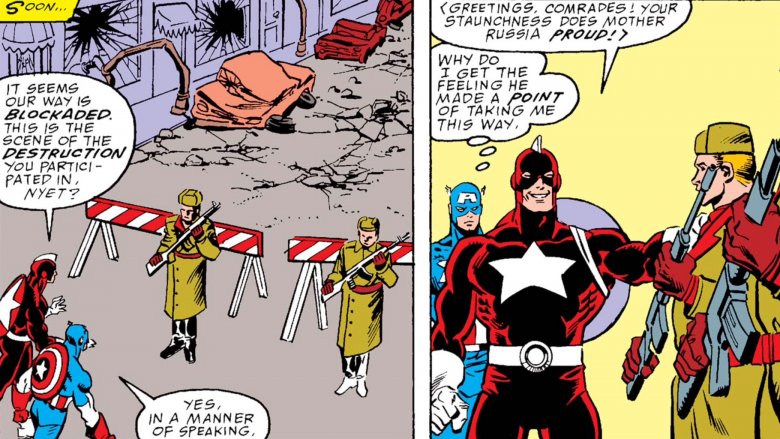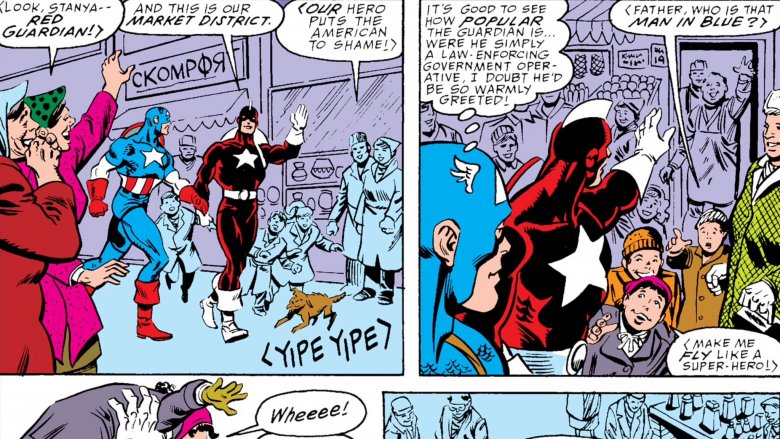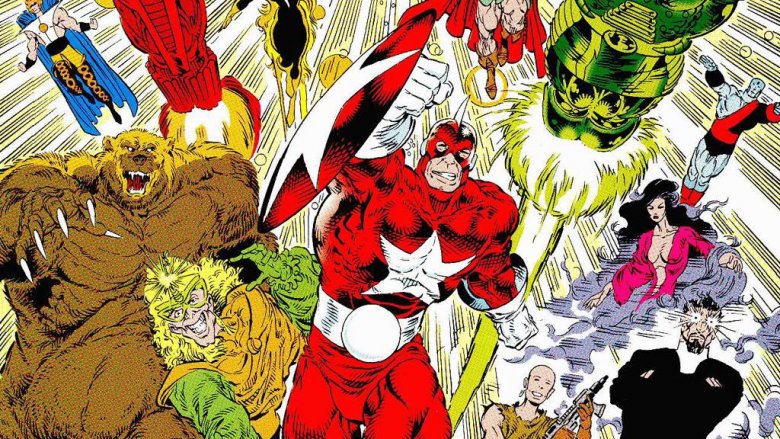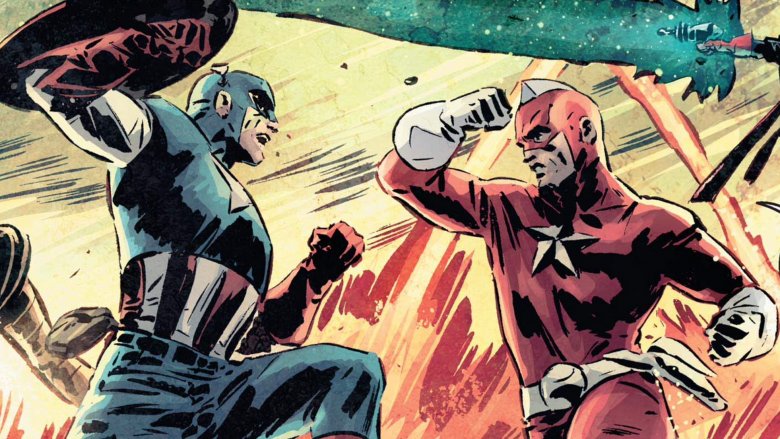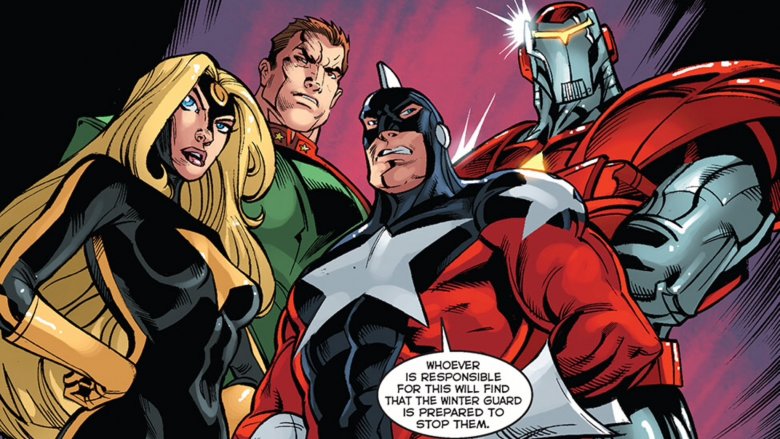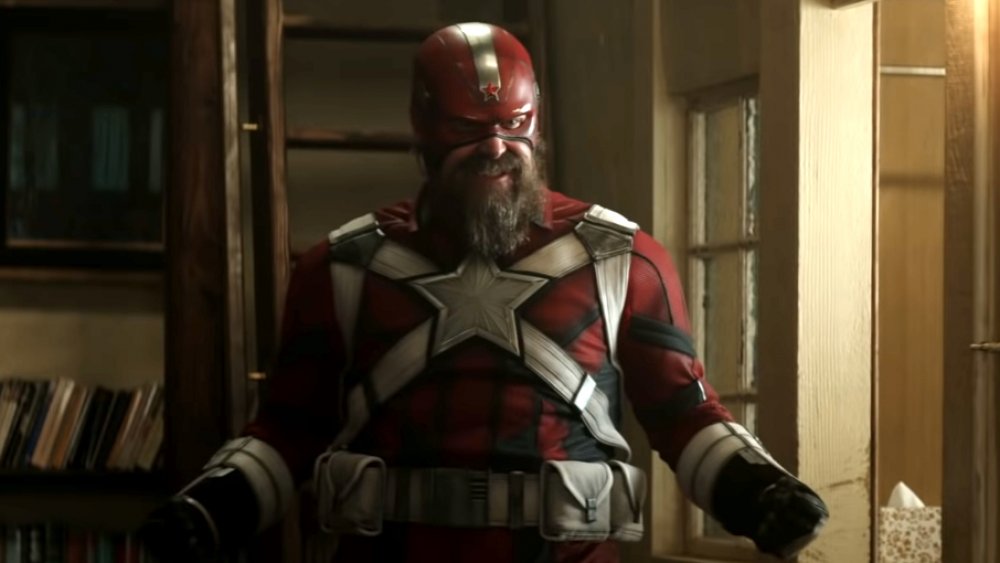The Untold Truth Of Red Guardian
At the 2019 San Diego Comic-Con, Marvel Studios revealed a whole lot of details about the Black Widow movie. Among the info they dropped was that David Harbour of Stranger Things and Hellboy fame would appear in the film as Alexei Shostakov, the Red Guardian. That's a character who's existed in Marvel Comics since 1967, although he's never really been a headliner. Basically, Red Guardian is the Russian version of Captain America. Shostakov is only one of many characters to use that identity in the comics, and in fact, he had the shortest run of them all.
However, Shostakov was the first Red Guardian, and he had a very important connection to Black Widow, so it makes sense that he'd be the one to appear alongside Natasha Romanoff in her long-awaited solo film. What makes the Red Guardian such an interesting character is that even though he was a Soviet agent introduced in the 1960s, he's never been a simple villain. Every iteration of Red Guardian has been a morally complicated character who defies simplistic comic book ideas about communists. So let's take a deep dive into the world of Russian superheroes by talking about the untold truth of Red Guardian.
Red Guardian as a 'dark mirror' of Captain America
The creation of the Red Guardian, or someone like him, was practically inevitable. The Cold War was a big part of 1960s Marvel Comics storytelling, and having a Soviet doppelganger was practically de rigueur for the major superheroes. For example, the Hulk fought the Abomination, a KGB agent named Emil Blonsky who'd been changed by gamma rays into an even bigger and uglier green monster. Iron Man faced the Crimson Dynamo, a Soviet physicist who built his own suit of super-armor. Spider-Man even went up against what seemed to be an exact duplicate of himself, but it turned out to be Dmitri Smerdyakov, a Russian super-agent better known as the Chameleon.
Interestingly, Steve Rogers' counterpart first appeared not in a Captain America comic but in Avengers #43. Stranger still, the first time Cap and the team encountered Alexei Shostakov, they weren't in Russia. Instead, they found Shostakov in China, where he was working with a communist Chinese agent named Colonel Ling. Captain America immediately recognized the Red Guardian as a copy of himself, which Shostakov acknowledged. Instead of a shield, this Red Guardian had a detachable belt buckle that he could throw as a weapon and then recall using magnets. It was a pretty silly 1960s gimmick, but the important thing was that having something round to throw at his enemies gave him that recognizable Captain America-esque aesthetic.
Shostakov's link to Black Widow
Although she wouldn't officially join the Avengers until a few years later, the Black Widow was with Earth's Mightiest Heroes when they first met the Red Guardian. By this time, Widow had stopped being a KGB spy, and she was a close ally and love interest of the Avenger Hawkeye. But as soon as she saw the Red Guardian, Natasha knew she recognized him, but she couldn't believe who he actually was. It turned out that the Black Widow's code name was more ironic than she realized, because the husband she'd long thought was dead had been alive all along.
Alexei Shostakov's death was faked by the KGB so that he could be secretly trained as the Red Guardian. Even though he'd allowed his wife to think he'd died, he was embittered when he learned she'd defected to the U.S. and was fraternizing with American superheroes. Natasha remembered her husband as a great Soviet pilot and war hero, but she was unprepared for the costumed super-brute he'd become. Of course, dramatic poignancy has its own power in superhero stories, and the Black Widow's code name wouldn't stay ironic for long.
Alexei Shostakov's redemption and death
It's easy to imagine a version of the Red Guardian who stuck around and became one of Captain America's top villains. He could've antagonized Cap again and again, with a different scheme each time, like a Cold War equivalent of Captain America's original archenemy, the Nazi Red Skull. If Stan Lee had still been plotting the Avengers when he was introduced, that might've happened. By 1967, however, a younger generation of writers was beginning to take over at Marvel, and Red Guardian co-creator Roy Thomas took things in a different direction.
The Red Guardian wasn't a nice guy, and you couldn't call him a superhero. However, he had a certain nobility to him. After all, how else could he be the first love of someone like Black Widow, who ultimately turned out to be a hero herself? He also had a measure of respect for Captain America, the hero who'd inspired his new costumed persona. So after running into the Avengers in China, Shostakov pulled a pretty impressive move. The superheroes were about to escape amid the complete destruction of a Chinese base, but as they were getting ready to go, the treacherous Colonel Ling planned on shooting Captain America in the back like the cowardly villain he was. And that's when Shostakov made a split-second decision to sacrifice his own life to save Cap, Natasha, and their allies. The Red Guardian may have been a supervillain, but he died like a hero.
Dr. Tania Belinsky, the second Red Guardian
The second Red Guardian — who was created by Steve Gerber and Sal Buscema and first appeared in Defenders #35 — wore basically the same costume as the first but was different in every other way. First of all, she was a woman, a Russian neurosurgeon named Dr. Tania Belinsky. Secondly, she wasn't a government operative. In fact, she used her costumed identity to protect dissidents within the U.S.S.R., as well as fighting crime. That was a pretty dangerous way to live, so when Doctor Strange brought her to the United States to perform delicate brain surgery, she decided to stick around.
As the Red Guardian, she became a member of the Defenders and a member of the American superhero community. Although she disagreed with the oppressive Soviet government, Tania was herself a communist, which gave her a different perspective on all sorts of matters from the rest of the Defenders, who were mostly American capitalists, plus one Asgardian Valkyrie and an Atlantean prince.
The Red Guardian becomes Starlight
During her time with the Defenders, the Red Guardian was targeted by a Russian agent named Sergei Krylov. He exposed both himself and Tania to a high dose of nuclear radiation, which gave them both superpowers, but it also made them highly radioactive. For a time, she was under his complete mental control, thanks to his new powers. But ultimately, Tania helped the Defenders defeat Krylov, now known as the Presence.
Unfortunately, the level of radiation she was giving off meant that the Red Guardian had to isolate herself from humanity to keep from killing everyone around her. In other words, her days as an active superhero were over, and she had to leave the Defenders. She would return from time to time over the years, and eventually, she got her radiation under control and operated under the name Starlight. However, she was never as prominent a character as during her initial run with the Defenders.
Josef Petkus, the third Red Guardian
The third Red Guardian was created by Mark Gruenwald and Kieron Dwyer, and he first appeared in Captain America #352. Named Josef Petkus, this Guardian represented a return to the original concept of a Soviet super-agent and direct counterpart to Captain America. But by his introduction in 1989, relations between the United States and the Soviet Union were much more civil, and the relationship between Captain America and the Red Guardian was likewise. There was tension and a bit of mistrust between the two super-soldiers, but they were ultimately allies.
In fact, the story that introduced the new Red Guardian had him taking Cap on a walking tour of Moscow, and then they fought a monster that turned out to be the manifestation of the sublimated powers of another group of forgotten Russian superbeings. It was a very different sort of story that perfectly represented the sometimes strained peace that existed between two of the world's superpowers as the Cold War drew to a close.
Josef Petkus was a genuine hero
In a certain sense, the Josef Petkus Red Guardian split the difference between Alexei Shostakov and Tania Belinsky. Like Shostakov, Petkus worked for the Soviet government and served as a mirror to Captain America, right down to carrying a shield of his own (instead of a flying belt buckle). However, like Belinsky, he was a true hero of the Russian people, not a brutish villain in a superhero's clothes. When he and Cap were strolling through Moscow in his first appearance, the Guardian was cheered and greeted affectionately by the public, who regarded him as a greater hero than his American counterpart. He even lifted a little girl who asked to "fly like a super-hero" and tossed the delighted child in the air. This was a time, even in the primary-colored world of superhero comics, when Americans were by and large ready to accept that being a communist — even being a Soviet — didn't mean you were a bad person, and the character of Josef Petkus reflected that.
What happened to the Red Guardian with the fall of the USSR?
On December 26, 1991, the Soviet Union collapsed after years of unrest and loosening restrictions. With no more Soviet government, there could be no more Soviet operatives as villains or conflicted heroes in comic books set in the present. Marvel Comics, with their 30-year legacy of Soviet supervillains, dealt with this by publishing a 1992 one-shot comic by Fabian Nicieza and Angel Medina, aptly titled Soviet Super-Soldiers. This title told the story of how the various costumed Soviet characters in the Marvel Universe dealt with the collapse of the state that had given so many of them their powers and identities.
Josef Petkus remained the Red Guardian, and he eventually became part of a reformed super-team called the Winter Guard, which kept the peace in Russia and around the world in turbulent times. He eventually changed his name to the Steel Guardian, and he gave his life in the line of duty, like the hero he'd always been.
Aleksey Lebedev, the new 'first' Red Guardian
For 24 years of Marvel Comics, Alexei Shostakov was regarded as the first Red Guardian. At some point, however, it occurred to somebody at Marvel that both Captain America and the Soviet Union had both existed for decades before 1967, so there was no reason not to have an earlier version of the character. So 1991's Namor, The Sub-Mariner Annual #1 — written by Dana Moreshead and Mike Thomas, with art by Phil Hester — introduced Aleksey Lebedev, the Red Guardian of World War II. Naturally, he was an ally of both Captain America and their British equivalent, Union Jack, against the forces of Nazi Germany. But after the war, Lebedev soon found himself opposing his former allies. Although his full story has yet to be told, he was said to have been killed by his own government during the 1950s, revising the origin story of the Alexei Shostakov Red Guardian to be an attempt to create a more loyal replacement for Lebedev.
The minor Red Guardians
As the flagship superhero of Russia, the Red Guardian often seems to be regarded by Marvel as more of a concept worth keeping around than a fondly remembered character, and thus, there have been more recent Guardians who were never really developed beyond a costume. Krassno Granitsky, the fifth Red Guardian, was introduced by Jorge Gonzales and Leo Fernandez in Maverick Vol. 2 #10. After appearing in three issues of that book, he was assassinated the very next time he showed up, in Captain America Vol. 5 #1.
The sixth Red Guardian first appeared in Hulk Vol. 2 #1 by Jeph Loeb and Ed McGuinness, and the only real name he was ever given was Anton. A member of the Winter Guard, he was by all accounts kind of a jerk, and he also turned out to be an android.
The seventh and most recent Red Guardian was Nicolai Krylenko, a Russian superman who was previously known as Vanguard. He first showed up under that name in 1978's Iron Man #109, but he didn't take on the identity of the Red Guardian until Darkstar and the Winter Guard #3 in 2010.
The Red Guardian arrives in the MCU
Here's what we know about the MCU Red Guardian, who appears in the upcoming Black Widow movie: He's played by David Harbour, and like the original, his name is Alexei Shostakov. He's a big middle-aged man with a big beard (an ideal David Harbour character), and in the trailer he's apparently putting on his costume for the first time in a while, because he's excited that it still fits. He shares a table with Natasha Romanoff (Scarlett Johansson), Yelena Belova (Florence Pugh), and Melina Vostokoff (Rachel Weisz), all of whom are also Soviet super-agents, and refers to them as a reunited family. The implication is that they were a team that went their separate ways years ago.
If any of them worked for the Soviet Union, which collapsed in 1991, they pretty much have to be older than they look. In Marvel Comics, after all, Natasha is around a hundred years old, but doesn't age thanks to the weird science of the Soviet project that created her. That's never been addressed in the MCU. In fact, in Captain America: The Winter Soldier, the computer consciousness of Arnim Zola says she was born in 1984. It seems very possible that this movie will disprove that.
In any case, it looks like David Harbour is having a lot of fun, and he seems to have some of the complexity of the Red Guardian from the comics, which should add a lot to the movie.
